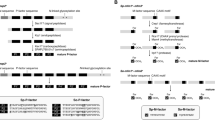Summary
We describe the identification of the following new sex pheromone plasmids inEnterococcus faecalis: a haemolysin-bacteriocin plasmid, pIP964; three R plasmids, pIP1017, pIP1438 and pIP1440; and two cryptic conjugative plasmids, pIP1141 and pMV120. The identification was based on the formation of cell aggregates on filter membranes during conjugation, on efficient transfer in broth matings, and on a positive clumping reaction of cells carrying these plasmids. In addition these plasmids hybridized with DNA probes specific for sex pheromone-induced structural genes encoding surface proteins required for conjugative transfer of the plasmids.
Similar content being viewed by others
References
Borderon E, Bieth G, Horodniceanu T (1982) Genetic and physical studies ofStreptococcus faecalis hemolysin plasmids. FEMS Microbiol Lett 14:51–55
Burdett V (1980) Identification of tetracycline resistance R plasmids inStreptococcus agalactiae (group B). Antimicrob Agents Chemother 18:753–760
Clewell DB, Weaver KE (1989) Sex pheromones and plasmid transfer inEnterococcus faecalis. Plasmid 21:175–184
Clewell DB, An FY, White BA, Gawron-Burke C (1985)Streptococcus faecalis sex pheromone (cAM373) also produced byStaphylococcus aureus and identification of a conjugative transposon (Tn918). J Bacteriol 162:1212–1220
Colmar I, Horaud T (1987) Enterococcus faecalis hemolysinbacteriocin plasmids belong to the same incompatibility group. Appl Environ Microbiol 53:567–570
Dunny GM (1990) Genetic functions and cell-cell interactions in the pheromone-inducible plasmid transfer system ofEnterococcus faecalis. Mol Microbiol 4:689–696
Dunny GM, Brown BL, Clewell DB (1978) Induced cell aggregation and mating inStreptococcus faecalis: Evidence for a bacterial sex pheromone. Proc Natl Acad Sci USA 75:3479–3483
Dunny GM, Craig RA, Carron RL, Clewell DB (1979) Plasmid transfer inStreptococcus faecalis: Production of multiple sex pheromones by recipients. Plasmid 2:454–465
Dunny GM, Zimmerman DL, Tortorello ML (1985) Induction of surface exclusion (entry exclusion) byStreptococcus faecalis sex pheromones: Use of monoclonal antibodies to identify an inducible surface antigen involved in the exclusion process. Proc Natl Acad Sci USA 82:8582–8586
Galli D, Wirth R (1991) Comparative analysis ofEnterococcus faecalis sex pheromone plasmids identifies a single homologous DNA region which codes for aggregation substance. J Bacteriol 173:3029–3033
Galli D, Wirth R, Wanner G (1989) Identification of aggregation substances ofEnterococcus faecalis after induction by sex pheromones. Arch Microbiol 151:486–490
Galli D, Lottspeich F, Wirth R (1990) Sequence analysis ofEnterococcus faecalis aggregation substance encoded by the sex pheromone plasmid pADI. Mol Microbiol 4:895–904
Horaud T, Delbos F, deCespedes G (1990a) Tn3702, a conjugative transposon inEnterococcus faecalis. FEMS Microbiol Lett 72:189–194
Horaud T, Delbos F, Pepper K (1990b) Does a tetracycline resistance determinant of class N exist? Antimicrob Agents Chemother 34:1447–1449
Horodniceanu T, Buu-Hoi A, LeBouguenec C, Bieth G (1982) Narrow host range of some streptococcal R plasmids. Plasmid 8:199–206
Ike Y, Clewell DB (1984) Genetic analysis of the pADI pheromone response inStreptococcus faecalis, using transposon Tn917 as an insertional mutagen. J Bacteriol 158:777–783
Jacob A, Douglas GI, Hobbs SJ (1975) Self-transferable plasmids determining the hemolysin and bacteriocin ofStreptococcus faecalis var.zymogenes. J Bacteriol 121:863–872
Jacob AE, Hobbs SJ (1974) Conjugal transfer of plasmid borne multiple antibiotic resistance inStreptococcus faecalis var.zymogenes. J Bacteriol 117:360–372
Kreft B, Marre R, Schramm U, Wirth R (1992) Aggregation substance ofEnterococcus faecalis mediates adhesion to cultured renal tubular cells. Infect Immun, 60:25–30
LeBouguenec C, Horaud T, Bieth G, Colimon R, Dauguet C (1984) Translocation of antibiotic resistance markers of a plasmid-freeSteptococcus pyogenes (group A) strain into different streptococcal hemolysin plasmids. Mol Gen Genet 194:377–387
LeBouguenec C, deCespedes G, Horaud T (1988) Molecular analysis of a composite chromosomal conjugative element (Tn3701) inStreptococcus pyogenes. J Bacteriol 170:3930–3936
Oliver DA, Brown BL, Clewell DB (1977) Analysis of deoxyribonucleic acid in a cariogenic strain ofStreptococcus faecalis: an approach to identifying genetic determinants on cryptic plasmids. J Bacteriol 130:759–765
Pepper K, Horaud T, LeBouguenec C, deCespedes G (1987) Location of antibiotic resistance markers in clinical isolates ofEnterococcus faecalis with similar antibiotypes. Antimicrob Agents Chemother 31:1394–1402
Tomich PK, An FY, Damle SP, Clewell DB (1979) Plasmid related transmissibility and multiple drug resistance inStreptococcus faecalis subspecies zymogenes strain DS16. Antimicrob Agents Chemother 15:828–830
Tomich PK, An FY, Clewell DB (1980) Properties of erythromycininducible transposon Tn917 inStreptococcus faecalis. J Bacteriol 141:1366–1374
Wanner G, Formanek H, Galli D, Wirth R (1989) Localization of aggregation substances ofEnterococcus faecalis after induction by sex pheromones. Arch Microbiol 151:491–497
Weidlich G, Wirth R, Galli D (1992) Sex pheromone plasmid pADI-encoded surface exclusion protein ofEnterococcus faecalis. Mol Gen Genet : -
Yagi Y, Kessler RE, Shaw JH, Lopatin DE, An F, Clewell DB (1983) Plasmid content ofStreptococcus faecalis strain 39-5 and identification of a pheromone (cPD1)-induced surface antigen. J Gen Microbiol 129:1207–1215
Author information
Authors and Affiliations
Additional information
Communicated by H. Hennecke
Rights and permissions
About this article
Cite this article
Wirth, R., Friesenegger, A. & Horaud, T. Identification of new sex pheromone plasmids inEnterococcus faecalis . Molec. Gen. Genet. 233, 157–160 (1992). https://doi.org/10.1007/BF00587574
Received:
Issue Date:
DOI: https://doi.org/10.1007/BF00587574




